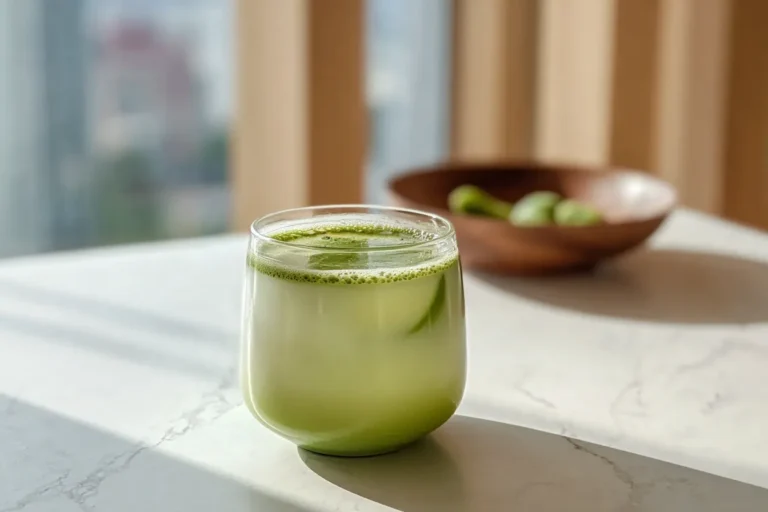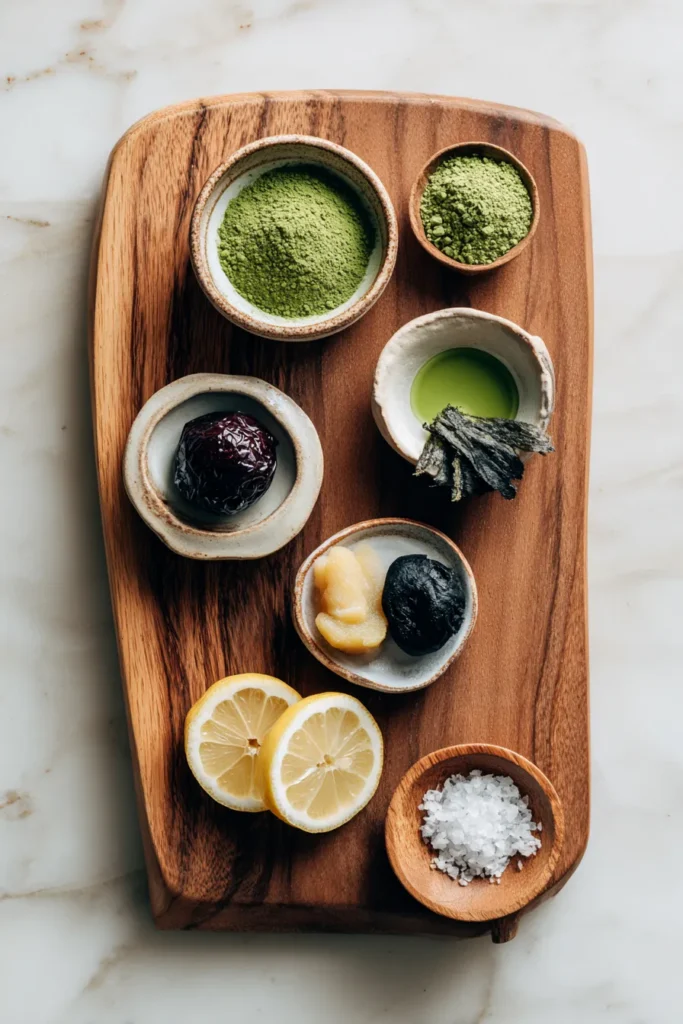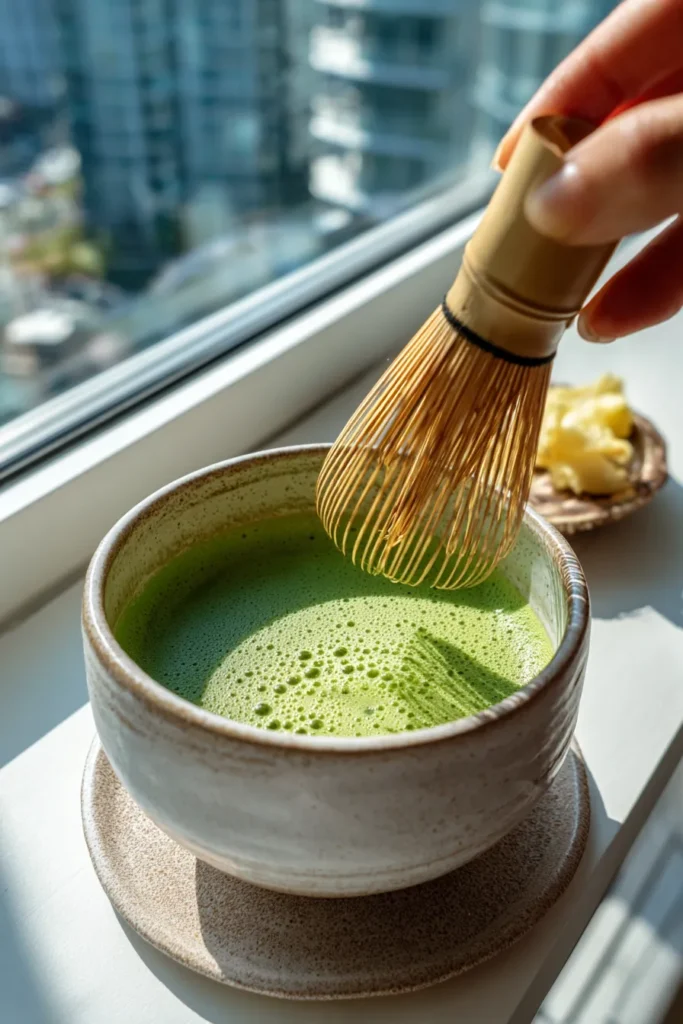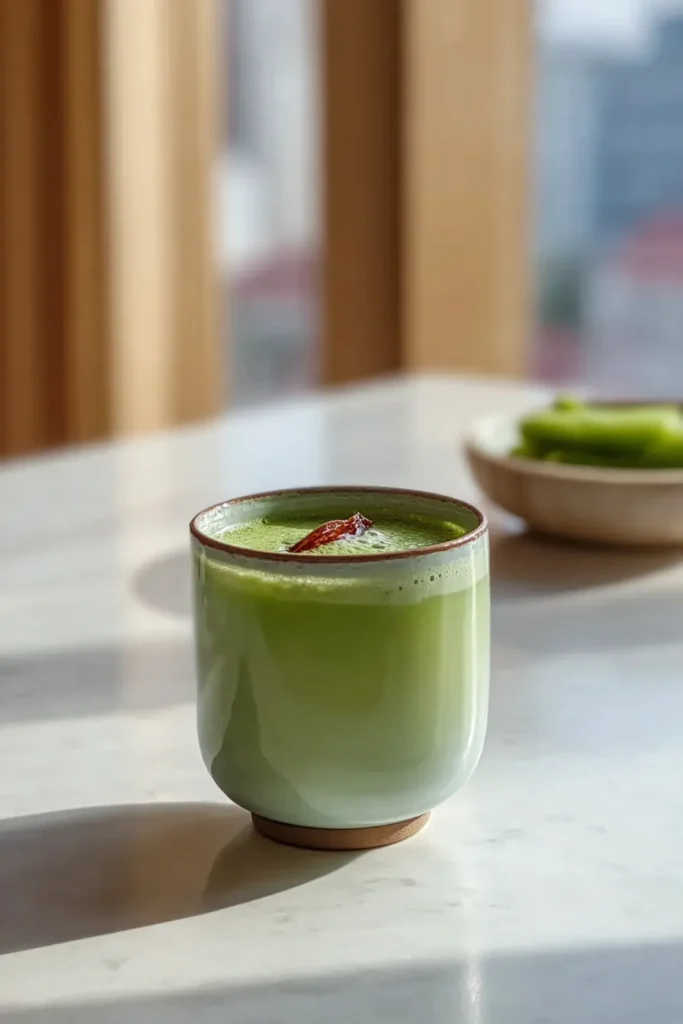I stumbled upon this Japanese Mounjaro Recipe during a search for gentle, holistic detox drinks—and it completely surprised me. Instead of citrus and vinegar, this version uses matcha, kombu, umeboshi, and fresh ginger. Just one warm cup in the morning makes me feel calm, energized, and ready to move into my day.
Here are the five reasons I keep coming back to it:
- Gentle detox support – The umami minerals in kombu and probiotics in umeboshi soothe digestion.
- Metabolism boost – Matcha and ginger help stimulate circulation and natural energy.
- Balanced flavor – Tangy umeboshi, earthy matcha, and warming ginger make each sip interesting.
- Soothing warmth – It’s gentle on the body and comforting throughout the day.
- Minimal ingredients – Four to five items, one warm cup no blenders or powders required.
Jump to
Why You’ll Love This Japanese Mounjaro Drink
When I started exploring weight-loss drinks rooted in tradition, this Japanese Mounjaro tea recipe stood out for its simplicity and layered health benefits. Unlike sugar-heavy detoxes or vinegar-heavy concoctions, this one felt balanced like something my grandmother might sip during a quiet afternoon.
Here’s what makes it special for me:
- Detoxifying without disruption – It supports digestion gently without causing urgency.
- Steady energy – The matcha delivers calm focus instead of jitters.
- Mild but flavorful – It’s not overpowering, yet it keeps my taste buds engaged.
- Comforting ritual – Preparing this warm drink has become a peaceful part of my day.
- Cultural resonance – This Japanese Mounjaro tea recipe is inspired by centuries-old healing practices, and I love feeling connected to that heritage.

Japanese Mounjaro Recipe: 5 Detox & Metabolism-Boosting Benefits
This Japanese Mounjaro tea recipe is a grounding, umami-rich tonic crafted with matcha, kombu, umeboshi, and ginger. Designed to gently energize, support digestion, and center your morning it’s both functional and ceremonial in feel.
- Total Time: 8 minutes
- Yield: 1 serving 1x
Ingredients
1 tsp matcha powder (ceremonial grade preferred)
1 umeboshi plum or 1 tsp umeboshi paste
1 tsp freshly grated ginger
1 small strip of kombu (about 2 inches)
8 oz warm filtered water (160°F)
Optional: 1 tsp lemon juice or a few drops of honey
Instructions
Warm water to 160–170°F and steep the kombu for 5 minutes.
In a separate bowl, whisk the matcha with a splash of warm water until frothy.
Remove kombu, then stir in grated ginger and mashed umeboshi.
Add the whisked matcha and gently swirl to combine.
Optional: Add lemon juice or honey to taste. Sip slowly while warm.
Notes
Add Ginger: Boost digestion with a pinch of freshly grated ginger.
Skip the Honey: For a low-sugar version, simply leave out the honey.
Use Cold Water: In hot weather, swap warm water for cold to create a refreshing drink.
Add Mint: A handful of fresh mint leaves adds a cooling, herbal touch.
Electrolyte Boost: Enhance hydration by mixing in a splash of coconut water.
- Prep Time: 8 minutes
- Cook Time: 0 minutes
- Category: Beverage, Wellness Tonic
- Method: Steeping, Whisking
- Cuisine: Japanese
Nutrition
- Serving Size: 1 cup (8 oz)
- Calories: ~25 kcal (with honey)
- Sugar: 1–3g
- Sodium: ~450mg
- Fat: 0g
- Saturated Fat: 0g
- Unsaturated Fat: 0g
- Trans Fat: 0g
- Carbohydrates: ~4g
- Fiber: ~0.5g
- Protein: ~1g
- Cholesterol: 0mg
How It Compares to Brazilian Mounjaro & Other 4‑Ingredient Weight-Loss Drinks
When I first tried the viral Brazilian and American versions of Mounjaro-inspired drinks, I noticed they often leaned heavily on citrus and vinegar.
You can explore the Brazilian Mounjaro recipe with apple cider vinegar for a contrast in flavor and acidity.
That’s when I started experimenting with a more grounded, savory version the kind of thing you’d sip slowly in a serene Japanese tea room. This Japanese Mounjaro recipe stands apart in flavor, function, and vibe.
| Feature | Japanese Mounjaro Drink | Brazilian / 4‑Ingredient Mounjaro |
|---|---|---|
| Core Ingredients | Matcha, umeboshi, kombu, ginger, water | Lemon, ACV, cayenne, water |
| Flavor Profile | Umami, earthy, tart-spicy balance | Tart, spicy, vinegar-heavy |
| Cultural Influence | Rooted in Japanese wellness traditions | Viral internet trends |
| Energy Experience | Calm, sustained focus | Quick jolt, sometimes jittery |
| Digestive Support | Kombu & umeboshi soothe the gut | Acidic ingredients may cause discomfort |
This Japanese Mounjaro recipe feels less like a shortcut and more like a practice. It’s not just about metabolism it’s about care, calm, and consistency.
Origin & Cultural Background
The soul of this drink traces back to traditional Japanese wellness rituals think kombu broths and umeboshi for digestion, or the meditative rhythm of whisking matcha.
If you love traditional tea flavors, you might also appreciate Hokkaido milk tea, a creamy Japanese tea tradition.
I grew up watching my grandmother sip warm tea infused with pickled plum when her stomach felt off. Years later, I realized she was on to something: combining calming ingredients that also support metabolism and digestion.
This version of the Japanese Mounjaro recipe reflects that tradition. It’s not about hacks. It’s about nourishment with intention.
Nutritional Profile & Health Insights
When I first started sipping this tea, I didn’t think much beyond the warmth it brought. But when I looked closer, I realized it was a powerhouse. The Japanese Mounjaro tea recipe offers potent antioxidants from matcha, digestion-friendly probiotics from umeboshi, and anti-inflammatory help from ginger. All with almost no calories.
Each cup has:
- About 10–15 kcal (depending on sweetener)
- 0g sugar if unsweetened
- A small caffeine boost from matcha
- Rich in iodine, chlorophyll, and catechins
Perfect for mornings, post-lunch slumps, or even wind-down rituals without overloading your system.
Calorie & Ingredient Swap Options
One thing I love about this drink? It’s forgiving. Whether I’m low on ingredients or just craving a twist, it adapts beautifully. For instance, in my Japanese Mounjaro recipe free of added sugars, I’ll skip honey and instead add a dash of yuzu or lemon for brightness. If I’m watching sodium, I’ll use a smaller portion of umeboshi paste rather than the whole plum.
Try these swaps:
- No caffeine? Use barley tea or decaf green tea powder.
- No kombu? Seaweed flakes or wakame can lend a similar mineral feel.
- Need sweet? A drop of monk fruit or a tiny spoon of raw honey works.
- Want it cold? Chill it and blend with ice for a slushy twist.
Ingredients for Japanese Mounjaro Tea Recipe
When I first crafted this drink, I wanted every ingredient to matter. That’s how this Japanese Mounjaro tea recipe was born from simple, intentional choices that support my energy and digestion without excess.
What you’ll need:
- 1 tsp matcha powder (ceremonial grade if possible)
- 1 umeboshi plum or 1 tsp umeboshi paste
- 1 tsp freshly grated ginger
- 1 small strip of kombu (about 2 inches long)
- 8 oz warm filtered water (about 160°F)
- Optional: 1 tsp lemon juice or a few drops of honey
I usually gather these into a little prep station on Sunday night it makes my weekday mornings feel like a calm tea ceremony.

Step-by-Step Instructions
Every time I make this Japanese Mounjaro recipe, I follow these steps like a little ritual. The order matters especially when it comes to extracting flavor without bitterness.
Step 1 – Steep the Kombu
Warm your water to about 160–170°F (never boiling). Place the kombu in and let it steep for 5 minutes. It’ll infuse the water with subtle umami and trace minerals.
Step 2 – Whisk the Matcha
In a separate bowl, add your matcha and a splash of warm water. Whisk briskly in a zigzag motion until frothy—this step feels meditative.
Step 3 – Combine & Flavor
Remove the kombu, then stir in your grated ginger and mashed umeboshi (or paste). Pour in the matcha and swirl everything gently.
Step 4 – Sweeten & Sip
Add lemon juice or a drop of honey if you like. Sip it slowly while it’s still warm it’s surprisingly comforting.
Helpful Tips for the Best Japanese Mounjaro Recipe
Through trial (and a few bitter matcha mishaps), I’ve learned how to make this drink smooth, flavorful, and effective. Here’s what helps most:
- Use filtered water and keep it around 160–170°F. Too hot and your matcha gets grassy.
- Whisk your matcha fully clumps can make the whole cup unpleasant.
- Ginger matters freshly grated ginger adds heat without bitterness.
- Kombu can steep twice I often save it and make a second cup later.
- Balance is key a dash of honey or lemon balances the tart umeboshi and earthy tea.

Flavor Variations & Customizations for the Japanese Mounjaro Recipe
I love how adaptable this drink is. Some days I crave a bit more heat, other times a touch of citrus. Here are my favorite tweaks:
- Citrus twist: Add a splash of yuzu or fresh lemon for brightness.
- Spice it up: A pinch of turmeric or cayenne gives it a deeper thermogenic push.
- Mint infusion: Drop in a few fresh mint leaves for a refreshing finish.
- Protein bump: Stir in a scoop of unflavored collagen for joint and skin support.
- Chilled version: Cool the blend, then shake over ice with extra ginger for a summer sip.
What to Serve with the Japanese Mounjaro Recipe
I usually sip my Japanese Mounjaro recipe either as a stand-alone morning reset or with something light to complement its savory edge. Here’s what pairs beautifully:
- Steamed edamame or a small seaweed salad both boost minerals and fiber.
- A small rice cracker or onigiri for texture and satisfaction without heaviness.
- Cold tofu with scallions and sesame oil for protein without added carbs.
- If it’s a sweet pairing day, I go for unsweetened matcha mochi or a tiny spoonful of kinako yogurt.
Week-by-Week Use Timeline & Results
From my first sip of this Japanese Mounjaro recipe free of additives or fillers, I started noticing shifts. Not dramatic overnight miracles but gentle, consistent changes that felt like my body saying, “Thank you.”
- Week 1–2: My digestion felt smoother. That heavy after-lunch bloat faded fast, and I was reaching for less between meals.
- Week 3: My midday focus sharpened. I didn’t feel sluggish at my desk, and I even ditched my second coffee.
- Week 4+: Skin looked clearer, and I noticed my pants fitting just a little looser. Plus, sipping this tea had become my moment of calm before the day revved up.

Random Facts About Japanese Wellness Drinks
These facts surprised me as I deepened my love for this Japanese Mounjaro tea recipe:
- Matcha contains L-theanine, which smooths out caffeine’s jittery effects no crash, just calm focus.
- Umeboshi plums are ancient hangover remedies in Japan, prized for liver support and digestion.
- Kombu is rich in glutamic acid, the natural compound behind umami flavor and it may support thyroid health thanks to iodine.
- Japanese tea rituals are meditative, inspired by the Zen principle of ichigo ichie “one time, one meeting.”
- Mounjaro-style drinks don’t need to be sweet they rely on earthiness, spice, and balance for satisfaction, not sugar.
Frequently Asked Questions
Q1: What is the Japanese Mounjaro recipe exactly?
It’s a warm drink made from matcha, umeboshi, kombu, and ginger designed to gently support metabolism, digestion, and hydration.
Q2: Is this Japanese Mounjaro recipe free to make?
Absolutely. Everything comes from whole ingredients no subscriptions, no powders. Just pantry staples you probably already have.
Q3: What does the Japanese Mounjaro tea recipe taste like?
Earthy, tangy, and a little salty from the umeboshi, with a clean green tea backbone and ginger warmth. It’s not sugary it’s savory wellness in a cup.
Q4: How many times a day can I drink this?
I usually sip it once in the morning and sometimes after lunch. It’s safe and gentle enough to enjoy two to three times daily.
Q5: Can I turn this into a cold version?
Yes just steep the kombu and ginger in warm water first, let it cool, then stir in chilled matcha. It’s a refreshing iced Mounjaro twist. Or try the Yerba Mate natural Ozempic alternative for a cold, herbal metabolism kick.
Storage & Maintenance
Storing your Japanese Mounjaro recipe correctly makes a big difference in taste and benefit. I always keep these simple rules in mind:
- Drink fresh—this Japanese Mounjaro tea recipe is most effective when consumed warm within 1–2 hours.
- Fridge storage—you can refrigerate the brewed tea (minus the kombu) for up to 24 hours.
For those who enjoy mineral-focused drinks, a pink salt hydration tonic makes a great companion to your morning Mounjaro routine.
- Reuse kombu—I often steep the same kombu twice. Just be sure to discard it after 12 hours.
- Matcha care—store your matcha in a dark, cool spot to preserve its nutrients and flavor.
- Clean tools fast—whisks and mugs should be rinsed immediately to prevent buildup from sticky umeboshi or powdered tea.
Whether you’re making a single batch or prepping ahead, handling your Japanese Mounjaro recipe free of preservatives keeps everything pure and effective.
Follow us on Medium and Pinterest for easy daily tips on natural weight loss, simple recipes like Purple Peel and Zepbound-inspired blends, and Pot Recipes you’ll want to share.
Final Thoughts
This Japanese Mounjaro recipe is more than just a tea it’s a ritual I’ve come to love. With just a few natural ingredients, I feel lighter, clearer, and more connected to my health. Whether you’re looking for a gentle detox, a metabolism lift, or just a calming start to the day, this blend has become my go-to.
Because it’s caffeine-friendly, warm, and deeply flavorful, I reach for this Japanese Mounjaro tea recipe every time I need a moment of reset. And the best part? It’s a Japanese Mounjaro recipe free of artificial ingredients, additives, or gimmicks just honest, functional wellness from a teacup.
Try it for a week and see what shifts for you your energy, your digestion, your cravings. It’s the small daily habits that build lasting change.





